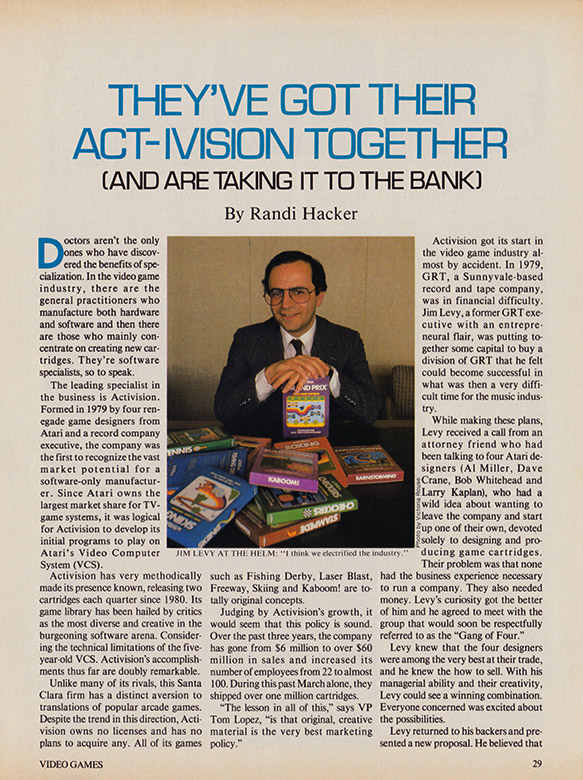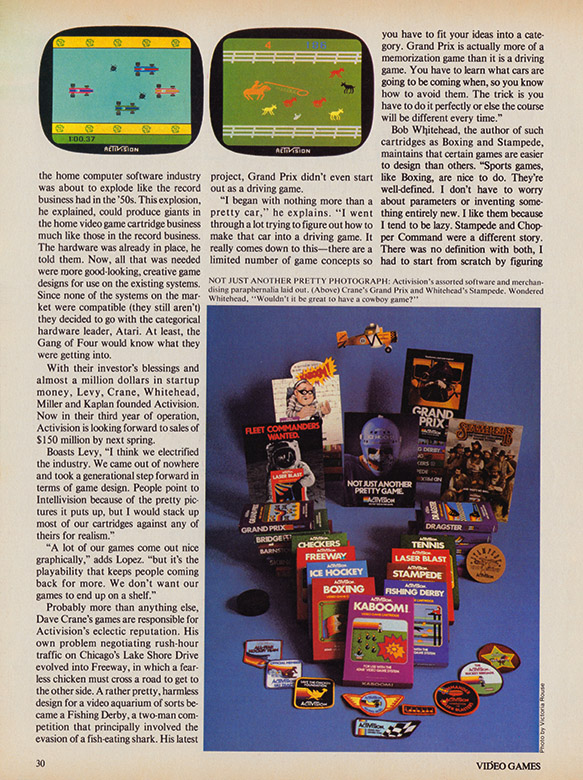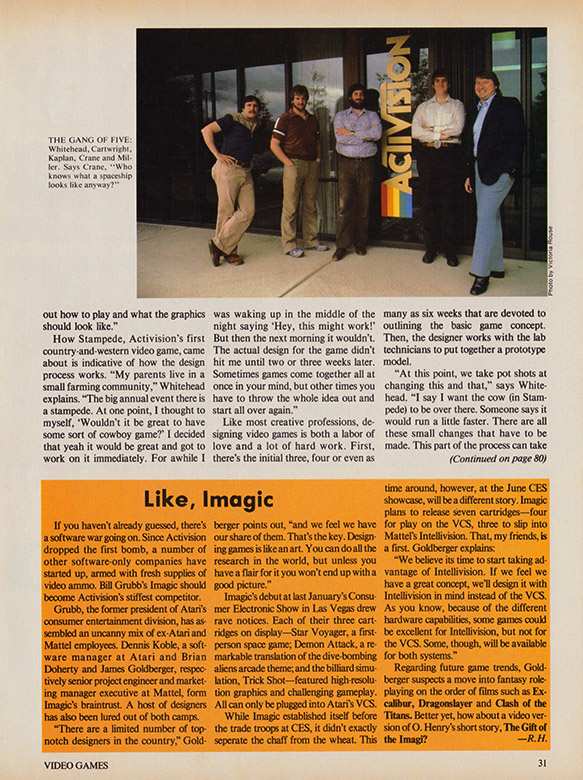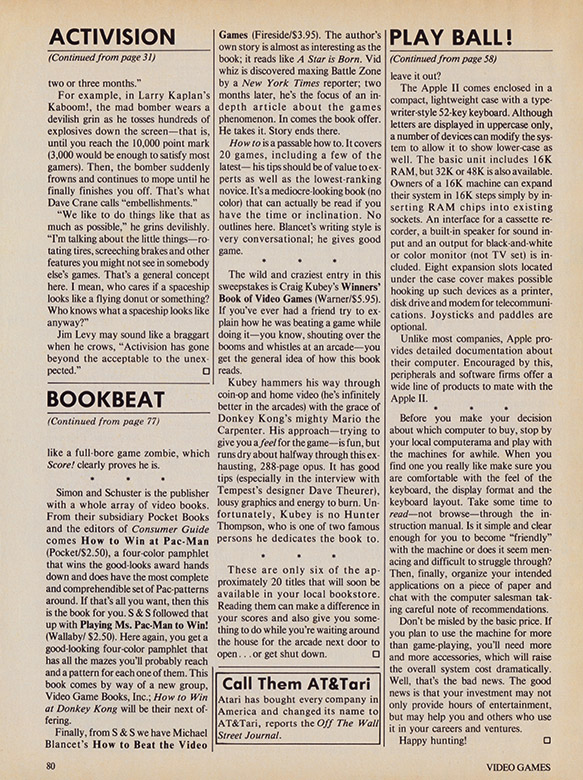
Activision
THEY’VE GOT THEIR ACT‑IVISION TOGETHER
(AND ARE TAKING IT TO THE BANK)
Doctors aren’t the only ones who have discovered the benefits of specialization. In the video game industry, there are the general practitioners who manufacture both hardware and software and then there are those who mainly concentrate on creating new cartridges. They’re software specialists, so to speak.
The leading specialist in the business is Activision. Formed in 1979 by four renegade game designers from Atari and a record company executive, the company was the first to recognize the vast market potential for a software-only manufacturer. Since Atari owns the largest market share for TV-game systems, it was logical for Activision to develop its initial programs to play on Atari’s Video Computer System (VCS).
Activision has very methodically made its presence known, releasing two cartridges each quarter since 1980. Its game library has been hailed by critics as the most diverse and creative in the burgeoning software arena. Considering the technical limitations of the five-year-old VCS. Activision’s accomplishments thus far are doubly remarkable.
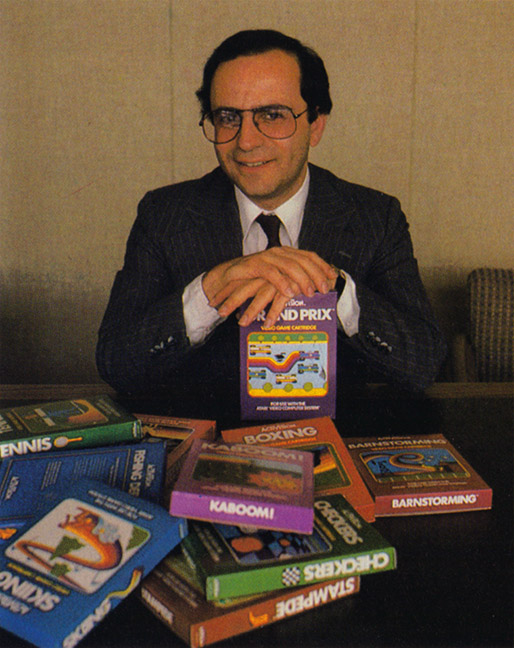
JIM LEVY AT THE HELM: “ I think we electrified the industry.”
Unlike many of its rivals, this Santa Clara firm has a distinct aversion to translations of popular arcade games. Despite the trend in this direction, Activision owns no licenses and has no plans to acquire any. All of its games such as Fishing Derby, Laser Blast, Freeway, Skiing and Kaboom! are totally original concepts.
Judging by Activision’s growth, it would seem that this policy is sound. Over the past three years, the company has gone from $6 million to over $60 million in sales and increased its number of employees from 22 to almost 100. During this past March alone, they shipped over one million cartridges.
“The lesson in all of this,” says VP Tom Lopez, “is that original, creative material is the very best marketing policy.”
Activision got its start in the video game industry almost by accident. In 1979, GRT, a Sunnyvale-based record and tape company, was in financial difficulty. Jim Levy, a former GRT executive with an entrepreneural flair, was putting together some capital to buy a division of GRT that he felt could become successful in what was then a very difficult time for the music industry.
While making these plans, Levy received a call from an attorney friend who had been talking to four Atari designers (Al Miller, Dave Crane, Bob Whitehead and Larry Kaplan), who had a wild idea about wanting to leave the company and start up one of their own, devoted solely to designing and producing game cartridges. Their problem was that none had the business experience necessary to run a company. They also needed money. Levy’s curiosity got the better of him and he agreed to meet with the group that would soon be respectfully referred to as the “Gang of Four.”
Levy knew that the four designers were among the very best at their trade, and he knew the how to sell. With his managerial ability and their creativity, Levy could see a winning combination. Everyone concerned was excited about the possibilities.
Levy returned to his backers and presented a new proposal. He believed that the home computer software industry was about to explode like the record business had in the ‘50s. This explosion, he explained, could produce giants in the home video game cartridge business much like those in the record business. The hardware was already in place, he told them. Now, all that was needed were more good-looking, creative game designs for use on the existing systems. Since none of the systems on the market were compatible (they still aren’t) they decided to go with the categorical hardware leader, Atari. At least, the Gang of Four would know what they were getting into.
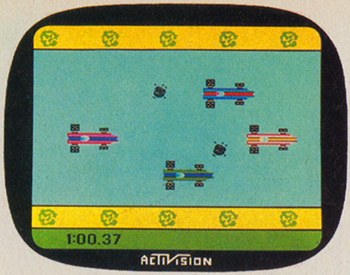
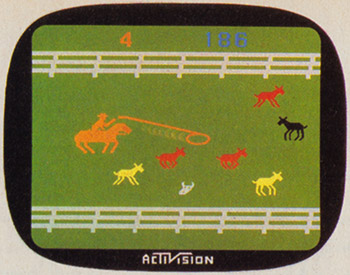
With their investor’s blessings and almost a million dollars in startup money, Levy, Crane, Whitehead, Miller and Kaplan founded Activision. Now in their third year of operation, Activision is looking forward to sales of $150 million by next spring.
Boasts Levy, “I think we electrified the industry. We came out of nowhere and took a generational step forward in terms of game design. People point to Intellivision because of the pretty pictures it puts up, but I would stack up most of our cartridges against any of theirs for realism.”
“A lot of our games come out nice graphically,” adds Lopez. “but it’s the playability that keeps people coming back for more. We don’t want our games to end up on a shelf.”
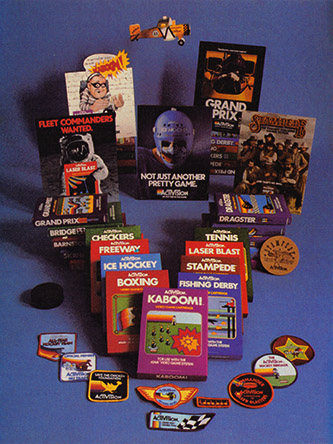
Probably more than anything else, Dave Crane’s games are responsible for Activision’s eclectic reputation. His own problem negotiating rush-hour traffic on Chicago’s Lake Shore Drive evolved into Freeway, in which a fearless chicken must cross a road to get to the other side. A rather pretty, harmless design for a video aquarium of sorts became a Fishing Derby, a two-man competition that principally involved the evasion of a fish-eating shark. His latest project, Grand Prix didn’t even start out as a driving game.
“I began with nothing more than a pretty car,” he explains. “I went through a lot trying to figure out how to make that car into a driving game. It really comes down to this—there are a limited number of game concepts so you have to fit your ideas into a category. Grand Prix is actually more of a memorization game than it is a driving game. You have to learn what cars are going to be coming when, so you know how to avoid them. The trick is you have to do it perfectly or else the course will be different every time.”
Bob Whitehead, the author of such cartridges as Boxing and Stampede, maintains that certain games are easier to design than others. “Sports games, like Boxing, are nice to do. They’re well-defined. I don’t have to worry about parameters or inventing something entirely new. I like them because I tend to be lazy. Stampede and Chopper Command were a different story. There was no definition with both, I had to start from scratch by figuring out how to play and what the graphics should look like.”
How Stampede, Activision’ s first country-and-western video game, came about is indicative of how the design process works. “My parents live in a small farming community,” Whitehead explains. “The big annual event there is a stampede. At one point, I thought to myself, ‘Wouldn’t it be great to have some sort of cowboy game?’ I decided that yeah it would be great and got to work on it immediately. For awhile I was waking up in the middle of the night saying ‘Hey, this might work!’ But then the next morning it wouldn’t. The actual design for the game didn’t hit me until two or three weeks later. Sometimes games come together all at once in your mind, but other times you have to throw the whole idea out and start all over again.”
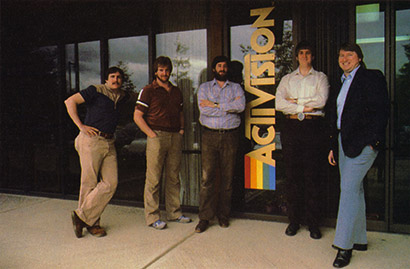
Like most creative professions, designing video games is both a labor of love and a lot of hard work. First, there’s the initial three, four or even as many as six weeks that are devoted to outlining the basic game concept. Then, the designer works with the lab technicians to put together a prototype model.
“At this point, we take pot shots at changing this and that,” says Whitehead. “I say I want the cow (in Stampede) to be over there. Someone says it would run a little faster. There are all these small changes that have to be made. This part of the process can take two or three months.”
For example, in Larry Kaplan’s Kaboom!, the mad bomber wears a devilish grin as he tosses hundreds of explosives down the screen—that is, until you reach the 10,000 point mark (3,000 would be enough to satisfy most gamers). Then, the bomber suddenly frowns and continues to mope until he finally finishes you off. That’s what Dave Crane cans “embellishments.”
“We like to do things like that as much as possible,” he grins devilishly. “I’m talking about the little things—rotating tires, screeching brakes and other features you might not see in somebody else’s games. That’s a general concept here. I mean, who cares if a spaceship looks like a flying donut or something? Who knows what a spaceship looks like anyway?”
Jim Levy may sound like a braggart when he crows, “Activision has gone beyond the acceptable to the unexpected.”
Like, Imagic
If you haven’t already guessed, there’s a software war going on. Since Activision dropped the first bomb, a number of other software-only companies have started up, armed with fresh supplies of video ammo. Bill Grubb’s Imagic should become Activision’s stiffest competitor.
Grubb, the former president of Atari’s consumer entertainment division, has assembled an uncanny mix of ex-Atari and Mattel employees. Dennis Koble, a software manager at Atari and Brian Doherty and James Goldberger, respectively senior project engineer and marketing manager executive at Mattel, form Imagic’s braintrust. A host of designers has also been lured out of both camps.
“There are a limited number of top-notch designers in the country;’ Goldberger points out, “and we feel we have our share of them. That’s the key. Designing games is like an art. You can do all the research in the world, but unless you have a flair for it you won’t end up with a good picture.”
Imagic’s debut at last January’s Consumer Electronic Show in Las Vegas drew rave notices. Each of their three cartridges on display—Star Voyager, a first-person space game; Demon Attack, a remarkable translation of the dive-bombing aliens arcade theme; and the billiard simulation, Trick Shot—featured high-resolution graphics and challenging gameplay. All can only be plugged into Atari’s VCS.
While Imagic established itself before the trade troops at CES, it didn’t exactly seperate the chaff from the wheat. This time around, however, at the June CES showcase, will be a different story. Imagic plans to release seven cartridges-four for play on the VCS, three to slip into Mattel’s Intellivision. That, my friends, is a first. Goldberger explains:
“We believe its time to start taking advantage of Intellivision. If we feel we have a great concept, we’ll design it with Intellivision in mind instead of the VCS. As you know, because of the different hardware capabilities, some games could be excellent for Intellivision, but not for the VCS. Some, though, will be available for both systems.”
Regarding future game trends, Goldberger suspects a move into fantasy roleplaying on the order of films such as Excalibur, Dragonslayer and Clash of the Titans. Better yet, how about a video version of O. Henry’s short story, The Gift of the lmagi?
—R.H.
Source Pages
